Come rain or shine, he stands in Times Square, strumming his guitar and croaking out a tune, almost naked except for cowboy boots, hat and the tight white briefs which occasionally reveal his politics.
To most, the Naked Cowboy is just another street performer, and not a very good one at that. But as he struts his stuff daily on Broadway for dollars from tourists, the Naked Cowboy is convinced he has achieved his goal of becoming "the most celebrated entertainer of all time."
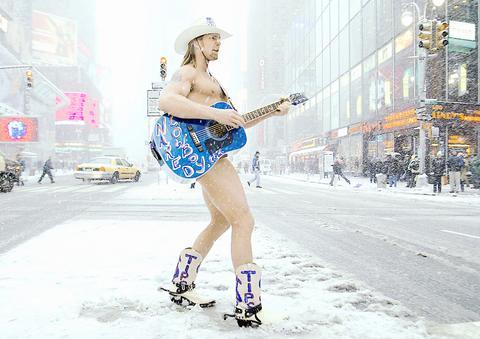
PHOTO: NY TIMES
"I've become the pin-up symbol of New York City," the Cowboy, also known as Robert John Burck, said. "I'm ready for the Statue of Liberty to throw down her torch and swim back to France." The Empire State Building? Strictly second-rate, he says.
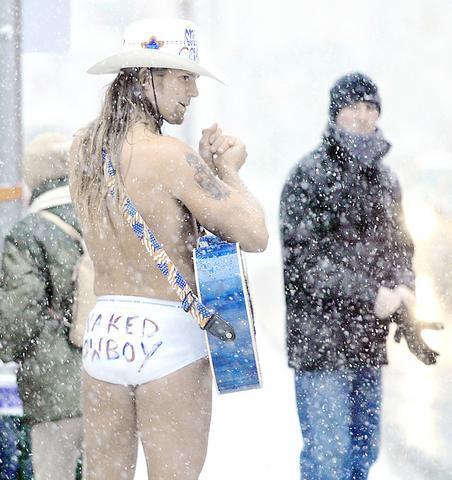
Dressed only in cowboy boots with spurs, a 10-gallon hat perched on his flowing blond hair and a double pair of form-fitting bright-white briefs, the Ohio native has become a daily fixture in Times Square over the past three years.
With his bodybuilder torso only partially obscured by his guitar, this street-corner Schwarzenegger interrupts his strumming and vocalizing to wrap a muscular arm around the latest in a stream of tourists -- virtually all women -- who stop to pose for a snapshot.
"Dollar in the boot -- no room in the underwear," he says, if the visitor fails to take the hint from the word "Tips" and the dollar signs painted on his white boots. He says he takes in US$700 to US$1,000 on an average day.
Burck takes his stand on a pedestrian island in the middle of Broadway, smack in the snarl of midtown Manhattan traffic, with the flashing signs of New York's theater district presenting a colorful backdrop.
On his Web site (http://www.nakedcowboy.com), 32-year-old Burck tells of setting a goal a few years ago to become the most celebrated entertainer of all time. Asked how that plan was coming along, he said he had achieved it.
"I've done more work than any other entertainer in the history of the world," he said. "It just hasn't been seen because it's been done with each individual person."
Comparing his fame with that of Jennifer Lopez, Burck said, "J Lo goes on TV and a billion people see her. I go to a billion people."
The only difference, in his view, is that he reaches his fans one at a time.
Burck's Web site chronicles in great detail a career driven perhaps more by ambition than by talent.
His first foray into show business came in 1997 after he won a Cincinnati radio station contest. The prize took him to California to appear as an extra on the television show Baywatch. He appeared onscreen "for about two and one-third seconds."
Back home in Ohio he took a few much needed voice lessons, borrowed a beat-up guitar from his mother and headed for Nashville, where he planned to become a famous country singer.
When this plan didn't quite work out, he returned to California to try playing for donations in Venice Beach. On his first day he grossed US$1.02. A friend suggested he needed a gimmick.
"Play in your underwear," the friend advised. "That'll make 'em stop."
The next day Burck returned in cowboy boots, hat and briefs, and his guitar case quickly filled up with dollar bills. The Naked Cowboy was born.
These days, Burck has "a suitcase full" of white cotton briefs. Most of them say "Naked Cowboy" -- his registered trademark -- in red and blue across the derriere, but the message sometimes becomes topical. During the Iraq war it read "Down with Saddam."
"I am the epitome of what America is," he said.
"It's about personal initiative. It's about ingenuity, entrepreneurship, capitalism, free markets. This is like the extreme of what you can do in America."
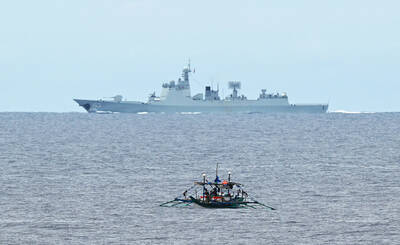
Late last month Philippines Foreign Affairs Secretary Theresa Lazaro told the Philippine Senate that the nation has sufficient funds to evacuate the nearly 170,000 Filipino residents in Taiwan, 84 percent of whom are migrant workers, in the event of war. Agencies have been exploring evacuation scenarios since early this year, she said. She also observed that since the Philippines has only limited ships, the government is consulting security agencies for alternatives. Filipinos are a distant third in overall migrant worker population. Indonesia has over 248,000 workers, followed by roughly 240,000 Vietnamese. It should be noted that there are another 170,000
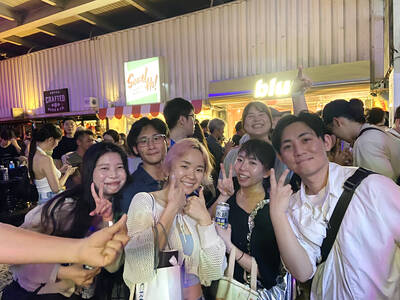
Hannah Liao (廖宸萱) recalls the harassment she experienced on dating apps, an experience that left her frightened and disgusted. “I’ve tried some voice-based dating apps,” the 30-year-old says. “Right away, some guys would say things like, ‘Wanna talk dirty?’ or ‘Wanna suck my d**k?’” she says. Liao’s story is not unique. Ministry of Health and Welfare statistics show a more than 50 percent rise in sexual assault cases related to online encounters over the past five years. In 2023 alone, women comprised 7,698 of the 9,413 reported victims. Faced with a dating landscape that can feel more predatory than promising, many in

“This is one of those rare bits of TikTok fitness advice with a lot of truth behind it,” says Bethan Crouse, performance nutritionist at Loughborough University. “Sometimes it’s taken a bit too literally, though! You see people chugging protein drinks as they’re scanning out of their gym.” Crouse recommends the athletes she works with consume 20-30g of protein within 30-60 minutes of finishing a resistance training session. “The act of exercising our muscles increases the breakdown of muscle proteins,” she says. “In order to restore, or hopefully improve them — and get gains such as increased muscle mass or strength —
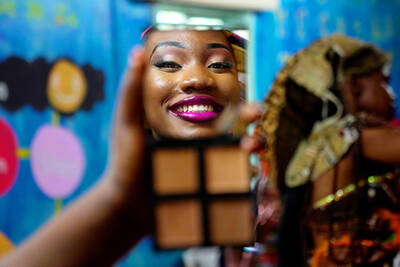
“Far from being a rock or island … it turns out that the best metaphor to describe the human body is ‘sponge.’ We’re permeable,” write Rick Smith and Bruce Lourie in their book Slow Death By Rubber Duck: The Secret Danger of Everyday Things. While the permeability of our cells is key to being alive, it also means we absorb more potentially harmful substances than we realize. Studies have found a number of chemical residues in human breast milk, urine and water systems. Many of them are endocrine disruptors, which can interfere with the body’s natural hormones. “They can mimic, block